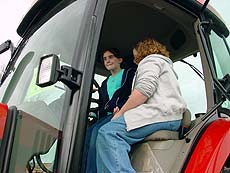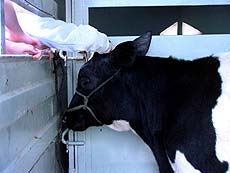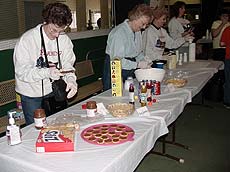|
Features,
Honors
& Awards, Ag
Announcements
Calendar,
Ag News Elsewhere
(fresh daily from the Web)
|
|
Features
|
|
War may
impact fuel costs
in crop production
[MARCH
26, 2003]
URBANA -- Tillage costs this
spring for Illinois farmers may increase from 5.6 percent to 8
percent per acre, planting costs from 2.2 percent to 5.1 percent and
additional operations from 3.3 percent to 5.8 percent per acre due
to increases in fuel-related costs said a University of Illinois
Extension farm financial management specialist.
|
|
"Fuel prices have increased
substantially primarily due to concerns over supply disruptions that
may occur in the Middle East," said Gary Schnitkey. "These price
increases have led to higher projected production costs for corn and
soybeans in 2003."
Schnitkey's study, "Increases in Fuel
Related Costs Lead to Higher Production Costs," is part of the Farm
Economics Facts & Opinion series and may be found online at
http://www.farmdoc.uiuc.edu/manage/
newsletters/fefo03_05/fefo03_05.html.
"Diesel fuel prices are currently
hovering around $1.50 per gallon, an increase of about 50 cents per
gallon over 2002 prices," he said. "Diesel fuel use for tillage,
planting and harvesting operations vary from farm to farm, with most
farms using between five and six gallons per acre. Fuel use of 5.5
gallons per acre and a $1 fuel price causes diesel fuel costs to be
$5.50 per acre. An increase to a $1.50 per gallon price means fuel
costs are $8.25 per acre, an increase of $2.75 per acre.
"This $2.75 increase only covers fuel
for field operations. Other fuel is needed for general use and grain
hauling, causing overall fuel costs to increase more than $2.75.
Average increases in fuel costs are likely to be around $3.50 per
acre, given that fuel prices do not decrease before the fall harvest
period."

[to top of second column in
this article]
|

Schnitkey's study also examines
nitrogen and liquefied petroleum gas prices, which have increased
dramatically since last spring.
"As many farmers applied anhydrous
ammonia in the fall, prior to most of the increase in price, per
acre nitrogen costs for these farmers will increase less than the 40
percent increase in prices," he said.
"Between February 2002 and February
2003, LP gas prices increased over 100 percent. This could indicate
that drying costs will increase dramatically if LP gas prices do not
decrease between now and summer."
Schnitkey said that quick resolution of
the war with Iraq might lead to substantial decreases in petroleum
prices.
"While LP and nitrogen prices are
impacted to some extent by uncertainties surrounding the Middle
East, analysts believe that price increases are due to long-term
increases in demand. If this is the case, there is less chance that
nitrogen and LP prices will decline dramatically with an Iraqi
resolution," he said.
The online
version of Schnitkey's study includes a table reflecting per acre
costs for various types of tillage, planting and row-crop
cultivation, and additional operations.
[U
of I news release]
|
|
 |
|
|
Weekly outlook
Wheat prices
[MARCH
25, 2003]
URBANA -- Beyond acreage,
2003 growing conditions and resulting average yields will be a large
determinant of wheat prices, said a University of Illinois Extension
marketing specialist.
|
|
"Large areas of below-normal subsoil
moisture conditions exist in U.S. wheat growing areas," said Darrel
Good. "However, the National Weather Service outlook for April, May
and June indicates near-normal precipitation and temperatures for
most growing areas. Smaller U.S. and world wheat inventories suggest
that wheat prices could become more volatile over the next few
months. It will likely take indications of another major shortfall
in production, however, to reverse the lower price trend.
"In the short run, wheat prices might
be influenced by the magnitude of food aid from the United States
and other countries following the conflict in Iraq. It is believed
that wheat could account for a large portion of aid packages."
Good's comments came as he reviewed
wheat prices, which traded to the highest level in over five years
in September 2002. December 2002 futures at Chicago traded to a high
of $4.40, May 2003 futures reached $4.22, and July 2003 futures
established a high of $3.80.
"The sharp increase in prices during
the summer of 2002 reflected a large reduction in crop size in the
United States and other major wheat exporting countries," said Good.
"The 2002 U.S. crop was 17 percent smaller than the 2001 crop, 28
percent smaller than the 2000 crop and the smallest harvest in 30
years.

"Production in other major exporting
areas -- European Union, Canada, Australia and Argentina -- was down
by 7 percent in 2002, with the largest decline of 62 percent coming
in Australia. Production in the EU was actually 13 percent larger
than the small crop of 2001."
Wheat prices over the past six months
have unfolded in a classic short-crop pattern, Good noted. From the
highs in early September 2002, May 2003 wheat futures declined
steadily through January 2003, mounted a small rally in February and
moved lower again in March. At the close of trade on March 21, May
futures were $1.36 below the contract high. July 2003 futures traded
in a similar pattern and at the close of trade on March 21 were
about 93 cents below the contract high.
"The impact of the small crops in
traditional exporting countries in 2002 was partially offset by
slightly larger production in traditional importing areas," said
Good. "Production in those areas in 2002 was 0.7 percent larger than
the 2001 crop but 16 percent larger than the 2000 crop. Much of that
increase was in the former Soviet Union.

[to top of second column in
this article]
|

"As a result, new wheat exports from
the former Soviet Union are projected at 764 million bushels this
year, up from 378 million last year and zero two years ago. In
addition, production in other parts of the world, primarily India
and Turkey, was up by more than 4 percent in 2002."
Wheat production outside the United
States was down only 0.7 percent in 2002. As a result, U.S. wheat
exports have been extremely disappointing during the 2002-03
marketing year. Those exports are now projected at 875 million
bushels, 86 million less than shipped last year.
"At that level, U.S. exports will be at
the lowest level in 31 years," said Good. "Projected U.S. wheat
exports this year represent 23.24 percent of projected world
exports. That is in the range of the U.S. share of world exports
over the past six years but is well off the 40 percent share of the
1970s and early 1980s."
The USDA now projects that stocks of
U.S. wheat at the end of the current marketing year (May 31, 2003)
will total only 465 million bushels. That is 312 million less than
stocks at the start of the year and would be the smallest
year-ending inventory in six years. However, that projection is 117
million bushels larger than projected in December 2002.
"Disappointing U.S. exports and
prospects of more abundant year-ending stocks have allowed wheat
prices to decline sharply over the past six months," said Good. "In
addition, world wheat production is generally expected to increase
in 2003. That expectation is based on the assumption of a return to
more normal weather and yields in the United States, Canada and
Australia and on ideas that world wheat acreage may increase in
response to high wheat prices."
U.S. winter wheat producers reported a
6 percent (2.5 million acre) increase in seedings for the 2003
harvest. The USDA's report on prospective plantings, to be released
on March 31, will reveal producer intentions for seeding spring
wheat.
"Expectations for that report are mixed," said Good. "Higher wheat
prices than those of a year ago would suggest an increase in spring
wheat seedings. However, some private sources are anticipating a
decline in spring wheat seedings due to the lower trend in prices
and some agronomic concerns. Instead, an increase in feed grain or
oilseed acreage in traditional spring wheat areas is expected."

[University
of Illinois news release]
|
|
 |
|
|
Nuisance fruit removal
By John
Fulton
[MARCH
24, 2003]
One of the main things to
discuss today is the removal of nuisance fruit. You may be thinking
about those apples or peaches, but really the nuisance fruit
category includes things that are much more a nuisance, like sweet
gum balls, maple seeds and crab apples. I used this topic a few
years ago in a column, and then there was a product shortage
locally, but I think that has been taken care of.
|
|
There are several products available to
eliminate nuisance fruit. The most common is ethephon, which is used
as a foliar spray to reduce or eliminate undesirable fruit or seeds.
Some of the trade names include Florel and Ethrel. The product is
effective at eliminating much of the fruit without affecting leaf
growth and color, and it does not harm other plants that get some
spray drift on them. It also does not affect the actual flowering of
the treated trees.
With ethephon, the key is in the
timing. The application must be made during flowering but before the
fruit sets in. For most flowering trees there is a 10- to 14-day
window of opportunity. Sweet gums are a little tricky since there
are no showy flowers involved, so effective sprays should occur just
as new leaves begin to emerge. Sprays should leave leaves wet but
not to the point of dripping. Good coverage of the tree is needed,
so keep in mind the size of the tree when you are weighing this
option.
This product is a growth regulator that
naturally occurs. Its natural production is stimulated by stress, so
make sure you aren't treating a tree that is under stress from
drought, high temperatures, diseases or other environmental
stresses. Treating stressed trees can cause severe injury to the
plant, such as leaf loss or scorching.
[to top of second column in
this article]
|
Lawn care
Normal spring grass seeding times are
March 15 until April 1. Seeding now may or may not have much
success. The key is in the weather. Spring seedings normally don't
have the success of the fall seedings. The worst timing gets new
seeds germinated but then frosted before a root system is
established. The recommended seeding rate for seeding bare ground is
four pounds of seed per 1,000 square feet. For over-seeding existing
grass, use two pounds. This same time period is also a great time to
do core aeration and dethatching
Several people have also asked about
weed control. Most broadleaf products are best put on around May 1,
while most preventive crab grass treatments are best applied just
before seeds germinate (this is based on soil temperature but will
be about the same time as forsythia blooms). Several of the winter
annual weeds, such as chickweed and henbit, are out now, but
concentrate on one item at a time. Seeding would come first, then
crabgrass treatments, then broadleaf treatments.
Master Gardener Walt Ebel
This past
week saw the passing of one of the initial class members of Master
Gardeners in Logan County. Walt Ebel lost his bout with cancer. Walt
was the founder of the Treemendous Tree Contest and also was a true
rosarian. His skills and knowledge will be greatly missed, and our
heartfelt sympathies to Walt's family.
[John
Fulton]
|
|
 |
|
|
County fourth-graders experience
a 'Celebration of Agriculture'
[MARCH
22, 2003]
More than 300 fourth-graders from Logan County visited
the Lincoln Park District Recreation Center Thursday. The
fourth-graders attended a half-day agriculture fair designed to give
the students knowledge of agriculture and its many uses in today's
world. The fair focused on the need people have for agriculture and
its importance in their daily lives. Nearly 100 percent of the
county's fourth-graders participated. Students attended from 13
schools in the county.
|
|
The fair was
sponsored by the Logan County Farm Bureau to coincide with
National Ag Day.
"Many students from
rural areas do not live on working farms," said Lynn Paulus of the
Farm Bureau. "The fair gives students an opportunity to experience
agriculture and the variety of uses farm products have."
Paulus said, "Three
county FFA chapters, from Mount Pulaski, Lincoln and Hartsburg-Emden,
helped present the fair."
The fair consisted of
presentations that were spread out over two half-hours. The
presentations included five breakout stations plus a sheep shearing
demonstration.
The fourth-graders
saw modern farm machinery, tractors, combines and a diesel truck.

"The tractors are
really big," commented Cody Mathis, a fourth-grader from Mount
Pulaski. Joe Rankin and Paul Stolzenburg agreed. All three students
said that they were enjoying the fair and learning a lot.
The Hartsburg-Emden
FFA presented a station that focused on safety and taking safety
precautions around farm machinery.
Another breakout
station was about corn and its many uses. Corn can be used in many
ways, ranging from food products to ethanol fuel to making plastic
and even clothing. A wedding dress was made using corn, and shirts
are made from materials using corn.
The fourth-graders
were very excited about what they did at the corn station. "We made
plastic," Dylan Hughes and Ethan Cline said. Levi Clampet said, "It
looks like burnt cheese." Connor Cruise said, "Mine looks like
blood." The students were obviously enjoying the presentations. They
were very excited about the interactive parts of the "celebration."
Other breakout
stations covered dairy products, hogs and pork products, and
soybeans and soy products.
Drew Olson from the
Hartsburg-Emden FFA helped students make ice cream at the dairy
breakout station. The students then got to enjoy tasting a sample of
their product.


[to top of second column in
this article]
|

John Erwin from
Beason brought his 7-month-old calf named Topper for the students to
meet. He also brought a portable milking machine. The fourth-graders
put their thumbs all the way up the tubing on the machine and
experienced the suction cows feel when they are being milked. This
was one of the fourth-graders' favorite stations.

[photos by Bob Frank]
At the hog and pork
station students sampled sausage, met a pig and learned about
nonedible products made from pork.
Ben Rekart, a
fourth-grader from Lincoln, said, "I learned that buttons can be
made from pork."
Ben also learned
about hog feed. The sample feed consisted of jellybeans that
represented water, M&Ms that represented vitamins, peanuts and
raisins that equaled protein, and candy corn and wheat for
carbohydrates. These nutrients are what hogs need in their food.
The soy products
station included a game of soy bingo featuring soy products as items
on the bingo board. MaryLou Klokkenga of the Emden Farm Bureau
women's committee also presented fourth-graders with samples of
foods made from soy, ranging from soy chocolate milk to soy butter
and soy crackers.

The final
presentation of the agriculture fair was a sheep shearing
demonstration. All of the fourth-graders sat in a circle watching as
a sheep was sheared. There were some "oohs" from the audience as the
shearing progressed. When the sheep was sheared, one fourth-grader
asked, "Does that hurt?"
The fourth-graders
from Logan County all seemed to enjoy the agriculture fair. They
showed a large amount of interest in all of the stations.
The students will now be asked to write
an essay about "The Celebration of Agriculture," which they must
submit by April 1. Students from the Phi Theta Kappa honorary
society at Lincoln College will judge which five essays are the
best. The five winners selected will receive trophies. From the
enthusiasm shown by all of the fourth-graders in attendance
Thursday, judging the essay contest will be very difficult.
[Don
Todd]
|
|
 |
|
|
Honors
& Awards
|
|
Ag Day
scholarship winners
[MARCH
25, 2003]
Six
area students received a total award of $4,000 in local Ag Day
scholarships -- double the amount awarded four years ago on the
first Ag Day.
|
|
$1,000 scholarship winners
Blane Olson -- senior at Mount Pulaski High School; active with FFA, National Honor Society, basketball;
will attend Lake Land Community College in the fall and then
University of Illinois or Illinois State to pursue a degree in ag
business; hopes to return to
family farm to produce soybeans and corn and expand swine operation
Abrigail Sasse -- senior at Lincoln Community High School; active with speech, 4-H, National Honor Society, band, community
volunteer; will attend U of I and major in animal science; hopes to have a
veterinary practice with small and large animals in Logan County

[to top of second column in
this article]
|

[photo courtesy of Bobbi Abbott]
Abrigail Sasse and Blane Olson
$500 scholarship winners
Casey Davis
-- junior at the U of I;
majoring in animal science, pre-veterinary studies
Natalie Coers -- senior at Hartsburg-Emden High School; heading to U of I to
major in ag education and communications, minor in horticulture
Kent Leesman --
2001 scholarship recipient; attending U of I;
majoring in crop science and agribusiness
Jason Wrage -- college senior recently accepted into the U of I College of
Veterinary Medicine; goal is to have a rural
mixed veterinary practice
|
|
 |
|
|
Ag
Announcements
|
|
Heartland Beef Alliance to
meet
|
|
[MARCH
24, 2003]
The
next meeting of the Heartland Beef Alliance will be March 29 in the
Illini Central High School agriculture classroom, beginning at 7
p.m. Dr. Bill Armbruster will be present to update beef producers on
health concerns. All beef producers in Logan, Mason, Tazewell
counties are welcome to attend.
[Betsy Pech,
secretary] |
|
|
|
|